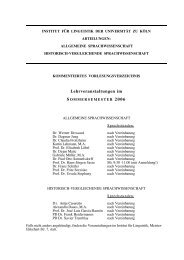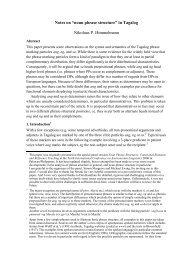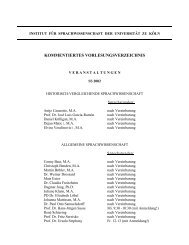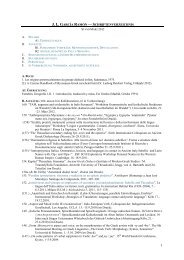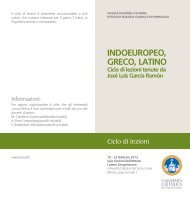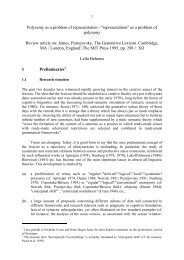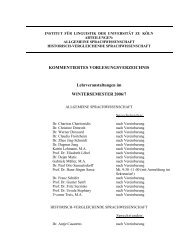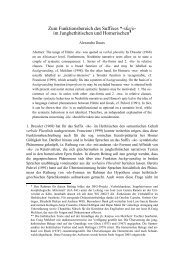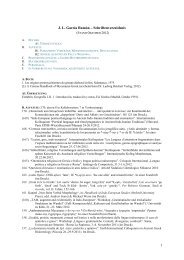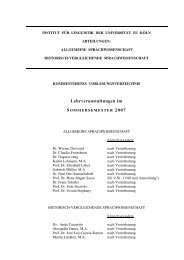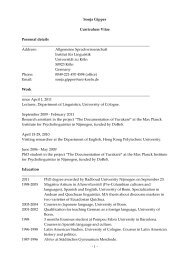Topics in Anatolian Historical Grammar Prof. Dr. H. Craig Melchert
Topics in Anatolian Historical Grammar Prof. Dr. H. Craig Melchert
Topics in Anatolian Historical Grammar Prof. Dr. H. Craig Melchert
Create successful ePaper yourself
Turn your PDF publications into a flip-book with our unique Google optimized e-Paper software.
Hittite Q-word questions 957<br />
with <strong>in</strong>formation focus on kuwat and replac<strong>in</strong>g focus on ki tepu (‘‘Not X,<br />
but Y’’). In (21) the angry deity should have been seek<strong>in</strong>g to do good for<br />
mank<strong>in</strong>d given the honours received by him, as the speaker rem<strong>in</strong>ds the<br />
angry deity. The noun idalauwani ‘for harm’ replaces the expected phrase<br />
assuli ‘for good’. Initial kuwat, <strong>in</strong> <strong>in</strong>formation focus, has scope over the<br />
preverbal constituent <strong>in</strong> replac<strong>in</strong>g focus. 20<br />
(20) She (the pr<strong>in</strong>cess) said:<br />
[ku]wat¼mu kī tepu pai-tta<br />
[W]hy¼me:dat.sg this:N.acc.sg little:N.acc.sg give-2sg.pst<br />
‘[‘‘W]hy have you given me this little bit’’.’<br />
(OH/NS narrative, a 81)<br />
(21) [E]a, K<strong>in</strong>g of Wisdom, said to Kumarbi:<br />
kuwat¼pat 21 ¼wa [ z]ik d Kumarbis dumu.lú.u 19 .lu-UTTI<br />
why¼foc.ptcl¼quot you:nom deity K. mank<strong>in</strong>d<br />
idalauwani -is[ki-si ]<br />
evil:dat.sg<br />
sanh˘<br />
search-iter-2sg.npst<br />
‘‘‘Why are you seek<strong>in</strong>g to harm mank<strong>in</strong>d, O Kumarbi? (Does not<br />
mank<strong>in</strong>d fetch a heap of gra<strong>in</strong> to promptly honour you,<br />
Kumarbi?’’)’<br />
(NH myth, KUB 33.103 ii 9–10)<br />
In English one could th<strong>in</strong>k of the follow<strong>in</strong>g INTERs with why <strong>in</strong> <strong>in</strong>formation<br />
focus and with ma<strong>in</strong> accent on the constituent <strong>in</strong> replac<strong>in</strong>g focus.<br />
(22) a. Why (did) SHE (eat them)? JOHN said he would eat them.<br />
b. Why (did she eat) the COOKIES? I thought she wanted to eat<br />
the CAKE.<br />
The representations of (17a) with only <strong>in</strong>formation focus on the whyphrase,<br />
(17b) with counterexpectational focus on the why-phrase and<br />
(20) with <strong>in</strong>formation focus on the why-phrase and replac<strong>in</strong>g focus on<br />
the preverbal constituent are (23a), (b) and (c), respectively:<br />
(23) a. (C I : [{(R I )(T I )}{(Bid Cs R J ) Inf IdFoc }](C I ))<br />
b. (C I : [{(R I )(R J )(R K )(T I )}{(Bid Cs R L ) Rej IdFoc }](C I )) 22<br />
c. (C I : [{(R I )(R K )(T I )}{(R J ) Repl IdFoc }{(Bid Cs R L ) Inf IdFoc }]<br />
(C I )) 23<br />
4.3. Comment focus and Q-word questions<br />
In comment focus clauses one of the subacts is what the other subacts<br />
‘‘are about’’. This subact is assigned topic function. To f<strong>in</strong>d the sentence



